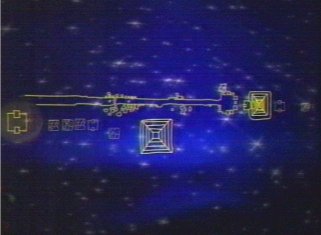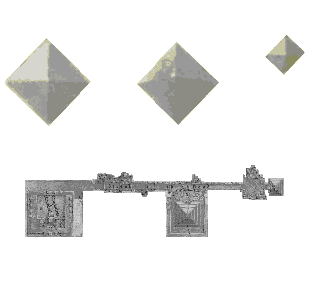The lost civilization of our past was not Atlantis
Thursday, March 09, 2006
What should be the standard of measure of a highly evolved society?
To me, the fact that I just microwaved a full meal under 4 minutes indicates that I have god-like powers (hmm...Instantaneous food); for others, perhaps super-heating a gas to
3.6 billion degrees Fahrenheit is a good indication that our civilization is at the bleeding edge of technology--all I can say about this is "holly crap, isn't this dangerous?"; for our ancestors, it seems that building large monuments gave them the nod of being highly civilized people.
Last week, I bought the book
Fingerprints of the Gods, by
Graham Hancock. If you are like me, any book with the word "God" in the title jeers my skepticism radar a bit. Regardless, I bought it and read it and enjoyed it.
Fingerprints is an interesting narration of an old theory of a super-advanced ancient civilization spreading a legacy of fantastic acts and tales all over the world.
These past civilization, we are told, was the one who built the pyramids that have been sporadically and randomly spread in the jungles of America, a couple of dry regions in Egypt, and every other continent.
Hancock claims that the similarities found in archeological sites around the world are not coincidental at all, but are the result of a weird mission of a knowledge-spreading "white bearded man" civilization with super powers. This bearded-man, the native legends go, visited America's Incas in Peru, the Mayas in Central America, and the Aztecs in Mexico--way before Columbus officially "discovered" America.
The Incas called this "god-like" man "Viracocha," the Aztec called him "Quetzatcoatl," and the Egyptians call him "Osiris."
His purpose was always the same: to teach them everything about agriculture and living in peace, and, lets not forget, how to build humongous dirt and stone pyramids.
Hancock tried, in 1996, to give a different answer to the old question of why these monuments of grand scale were necessary. He wanted us to consider the alternative answer that these monuments were not just tombs for kings, but computers used to calculate and predict the end of the world--which is, by the way, December 23, 2012. I don't mean to be an alarmist here, but are you ready?
The proof of existence of this god-like civilization is speculatory at best, and none to be found anywhere at worst. Consider for example Chapter 22, where he talks about the City of the Gods, in Teotihuacan, as being built to represent a model scale of our solar system, including all nine planets--even
Pluto, which was only discovered a few years ago. If you don't believe me, check this out:


Along the same lines, one Engineer claims that the main city street was flooded with water and from the top of the pyramids you could see the water rippling through and this was used to tell different cataclysms around the world--I have to admit that this is a bit much, but is it pure coincidence that the site's structures perfectly depict the solar system? To this day, no one really knows why the city was built.
(About the rippling river of the City of Gods: remember Jurassic park and the scene with the cup of water and the running T-Rex--well, it is similar but think of the cup being a very large cup, and not a cup at all, but an artificial river surrounded by eerie looking pyramids. I'm guessing peyote was used at some point of the ordeal.)
What is extraordinary about these claims is that all these accomplishments of architecture and astronomy came from a civilization that, supposedly, existed 10,000 years ago (right around the last ice age).
I am gullible, so all these fantastic "coincidences" do not sound like coincidences at all.
However, I have one big "IF" about the whole thing...
It is a given that the people who built these monuments were quite gifted in all sorts of sciences, including politics, architecture, engineering, and mathematics--otherwise, they would have not been able to coordinate so much raw materials and human resources--but, why I wondered, would they build these massive stone and dirt computers to do something we can now do with a silicon chip the size pin head?
You may logically counter that these monuments do not need electricity and that they will outlive most of us. True, but why create such big stone computers? Why not a "laptop" stile stone-computer? (Maybe I have to look at the
Maya Calendar for that.)
Another question of mine: why is it that they didn't develop into an information society, the way our current civilization did in only 2,000 years?
Technological advances have quite a slippery and steep slope: once you start riding it, you can't escape it--look at what we have accomplished in the last 30 years.
What were the limitations these "advanced" societies of 10,000 years ago encountered that did not allow them to produce the overall advances that we have as a global society now a days? Why didn't they invent google, or the internet, or atomic bombs?
Perhaps they didn't have enough people with enough free time, as we do now, to invent seemingly useless crap (Napster, for example, wasn't so useless once you went beyond the copyright infringement thingy). Overpopulation has its benefits, so it seems; and maybe reading and writing for the average Joe may have done wonders for our current state of affairs.
The legends do cite these "white bearded men" arriving to these lands (and others) via "floating" or "flying shiny serpents"; or that 100 tons of solid rock were lifted and moved around the air with the aid of a whistle; or that these demi-gods could make the sky spit fire on command.
If these legends are true, then this Viracocha race did have the sort of technology we will have in 50 years from now. Hell, I can even say the technology we currently have: flying mechanical birds, speed boats, missiles, laser guns, picture taking phones, iPods, etc., etc.
I mention all these things because most of their construction or usage depend on electricity, opposite to the old monument-computers that didn't require anything to function except the right mathematical development (and we've only reach that level after 5,000 years of written history).
I wonder if this god-like race discovered and used electricity? I mean, an electron has been an electron, and will probably still be an electron billions of years from now. So I think it a fair question to ask, when legends are telling us that they could make crap fly around by the mighty power of a whistle. It is hardly a big stretch of the imagination to suggest they understood a bit of the fundamental components of matter and that electrons are negatively charged and could be transferred and channeled to do stuff. (I get that the allusion to a "whistle" is probably to something related to an anti-gravity instrument--but whistle just sounds funny.)
Why wouldn't these benevolent race give all these "secrets" to the semi-nude savages? (As opposed to just showing off). And why would they keep them in the dark about their origins? Why so many myths? Why allow them to carve rocks depicting their awesome powers? One thing is for sure, deities seem to like to be venerated.
My biggest question is why make them toil for decades at a time without any real benefit to them, except the realization of a job well done?
I have so many questions...
In the mean time, I can only imagine the equivalent of a present me, say "Jose Viracocha," in 2005 B.C. saying to himself: "My back hurts and I'm hungry, but this white bearded-god-man says we need to build this pyramid, and pronto. So I will work for corn and pray to him for more excruciating pain for another, what, 30 years more...By the way, this rock and dirt pyramid is turning out beautiful--I don't know what it is for, but I'm sure glad I'm a part of it."
Unless of course Viracocha/Quetzalcoatl/Osiris was indeed a god or an alien, I don't really see the point of forcing or "divinely persuading" thousands and thousands of an illiterate population to keep constructing these monuments as markers of past and future catastrophes.
(But, just in case they were gods and are still returning as they promised every race they visited, I don't want to sound irreverent, so if they are reading I personally welcome our Viracocha overloads--and most importantly, where do I sign up for forced pyramid building labour? I loves to build me one of them tombs...)
On a serious note, the book is very entertaining and gives you this guilty pleasure of being initiated into a secret that only few know (well, at least the thousands and thousands who have bought the book and now the three of you reading this web site). The claims are so extraordinary, I sometimes forgot I was reading about "real" events and real places, but the few math references appealed to my geeky side so I enjoyed the tales and archeological detective work.
The big secret and summary of the book, in a nutshell (sorry for the spoiler): there was once a civilization so great, composed of men (and women, I supposed--weird, women never show up on most of this ancient myths) who knew everything about the roundness of the Earth, that understood the phenomenon of the Earth's precession and how it relates to the seasonal changes. Moreover, this super advanced raze may have lived in Antartica when the continent was not where it is right now, but was around equatorial latitudes and it is where it is now because of some cataclysmic Earth crust movement, and finally, they (the demi-gods) decided to leave markers and computers in the forms of stone monuments so that we could understand what happened and will happen to the world.
To me, everything sounds feasible but there are those things that don't quite add up and we will probably never know why this math knowing and great architects built such large monuments with apparently no real use. Perhaps "never" is too strong of a word, but archeologist and linguist will have to get their act together to figure these things out (if not them, then who).
There are claims that there was actually a written history left by the Mayas and Aztecs about this lost civilization, but everything that was not carved in stone was mostly burnt and destroyed at the time of the conquest by eager Catholic priests and Spanish conquistadors.
In truth, we can use numbers to associate anything to anything if we really wanted to. So a problem I have is that we are trying to retrofit our current knowledge to these old monuments with the aid of mathematics. However, if indeed these 10,000 year old undiscovered civilization knew then all we know now, they were indeed god-like Viracocha/Quetzatcoatl/Osiris and deserve their tales to have been immortalized in pieces of rock.
By the way, I give
Fingerprints "4 great pyramids of Giza out of four," but if you read the book you must keep repeating to yourself "I want to believe...I want to believe...I want to belie..." Hey, isn't that the motto for the X-files? So that you know, I didn't like the X-files that much; I only saw a few episodes.
And to keep feeding the
fire, check this aerial view of Giza and Teotihuacan:

How is that for coincidental alignment of totally unrelated monuments?
Comments:
do you have a bigger version of the teotihuacan vs. solar system diagrams ?
Unfortunately, I don't have any more diagrams. I'd google for them, and perhaps transpose the two best versions you find.